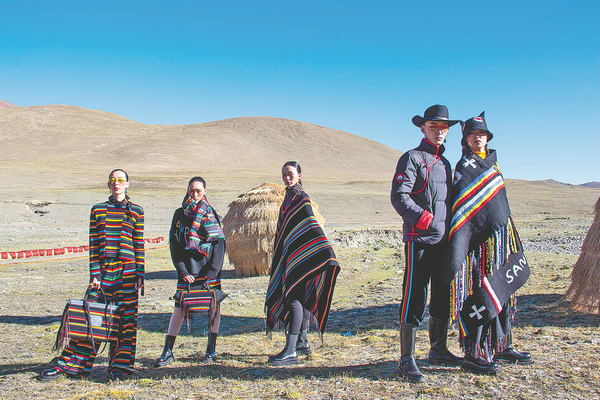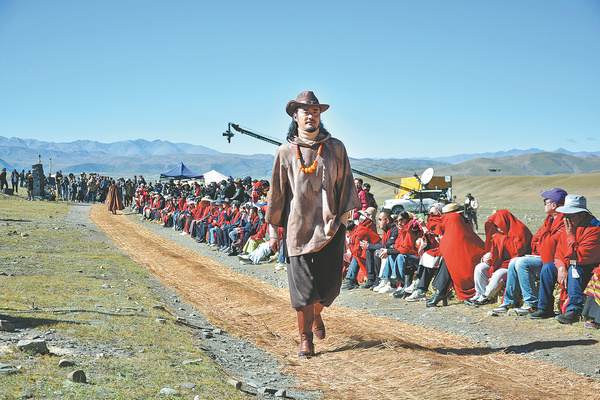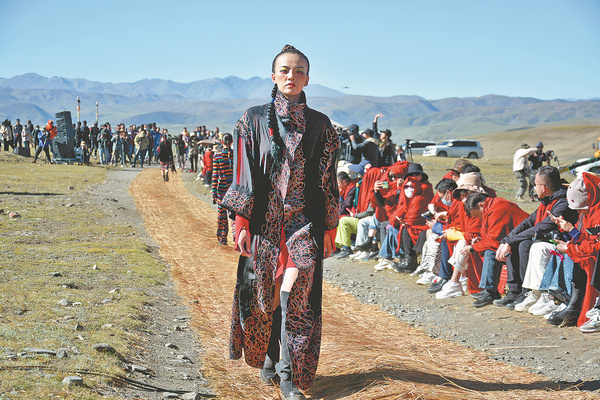Shanghai-Tibet collaboration takes traditional clothing to brand new heights
Updated: 2023-10-16 By PALDEN NYIMA in Lhas (China Daily)  Print
Print 



A fashion show featuring traditional Tibetan clothing held in Gyalze county, the Tibet autonomous region, last month, combining tradition and modern design. CHINA DAILY
Under clear blue skies and with the snowcapped Nechen Kangsang Mountain as a backdrop, a fashion show was held at Mayor village at an altitude of 4,800 meters. The models presented a heart-stopping visual feast for spectators.
The show, featuring the traditional clothing of Shigatse city in the Tibet autonomous region, was held in Gyalze county in mid-September, and showcased the alluring combination of traditional Tibetan clothing and modern design.
Locally produced woolen cloth, or nambu, is part of the region's long and deep traditional costume culture. Nambu is woven out of wool and cashmere, and is widely used as a material in Tibetan clothing, including robes, hats, boots and sheets.
It not only reflects the folk customs of Tibet, but also demonstrates the harmonious coexistence of all ethnic groups in the region with nature, Guo Xiuling, founder of Chinese brand Sand River, was quoted as saying by Tibet Daily.
As the planner of the show, Guo says that under the guidance and matchmaking of the Aid Tibet cadres from Shanghai, Sand River's designs have been integrated with Tibetan woolen cloth craftsmanship, creating a visually impactful collision between traditional woolen clothing and modern fashion design.
By introducing Shanghai's traditional craft enterprises and industry leaders to Shigatse, Aid Tibet has been supporting the production of traditional woolen textile products in recent years, helping local craftsmen improve processing, design and quality to make it more attractive to consumers, brands and markets.

A fashion show featuring traditional Tibetan clothing held in Gyalze county, the Tibet autonomous region, last month, combining tradition and modern design. CHINA DAILY
A range of products with Tibetan elements in line with public aesthetics have been produced, and they have been working to transform this unique advantage into an economic benefit. Sand River acts as a bridge between grassroots material producers and market expansion.
All the clothing displayed in the fashion show is made manually by women from the villages of Gyalze county, and the added value of Tibetan clothing has been upgraded by incorporating modern designs.
Guo says that her company uses natural, sustainable raw materials like cashmere and yak hair, which are completely biodegradable. It incorporates traditional Tibetan culture into the production process, taking inspiration from elements like Tibetan opera, and intangible cultural heritage handcrafting techniques have been adopted during production.

A fashion show featuring traditional Tibetan clothing held in Gyalze county, the Tibet autonomous region, last month, combining tradition and modern design. CHINA DAILY
"There is zero waste as the remaining materials are made into products, such as earrings and puppets," Guo says.
She believes that the integration of traditional handicrafts with the market economy is a smart way of contributing to the preservation of traditional culture; the more people purchase, the more it contributes to cultural inheritance.
"I am looking forward to using the market as an engine to promote the creative transformation and innovative development of intangible cultural heritage. Surprisingly, nambu products are highly sought-after by both domestic and overseas consumers, and they have to reserve their purchases in advance," she adds.
Champa, who works at a Tibetan clothing cooperative in Gyalze township in Gyalze county, says that he and his colleagues are pleased to be working with Sand River, and that it has boosted their business.
The cooperative comprises 15 members from 15 households, most of whom are women. In the past, they only made traditional clothing and Tibetan carpets from wool and cashmere, and business was not very good as the market was limited.
"By working with Sand River, our orders have reached 200,000 yuan ($27,000) this year, and we have signed a contract for 3 million yuan worth of orders in 2024 already. It's a huge jump," says Champa.
His cooperative will add more advanced textile machines in the coming weeks, as well as 13 new staff members to raise production. Existing workers will each take an apprentice to train.
"Now we have a broader market; it encourages our cooperative members to work harder than before, as they earn more by doing so."
palden_nyima@chinadaily.com.cn








